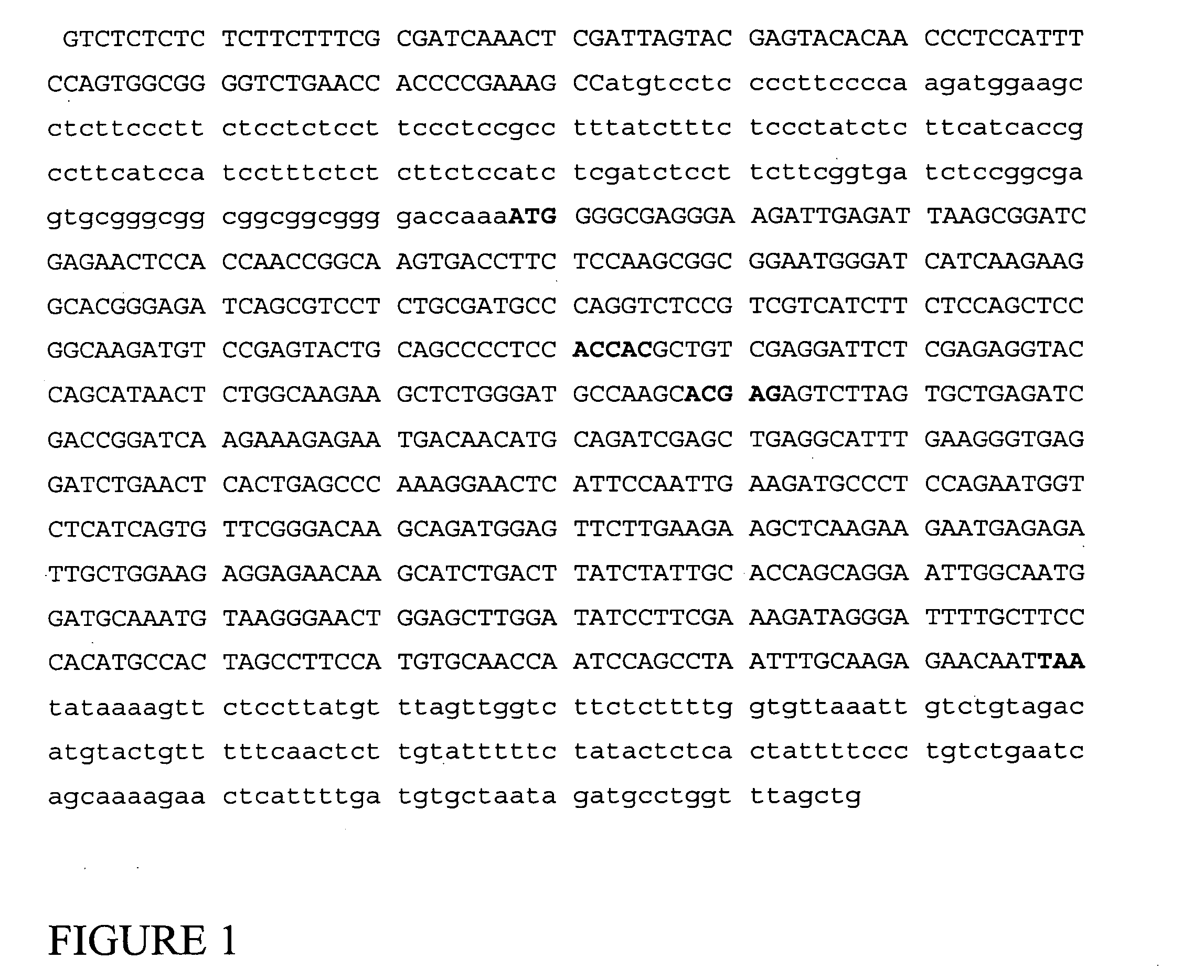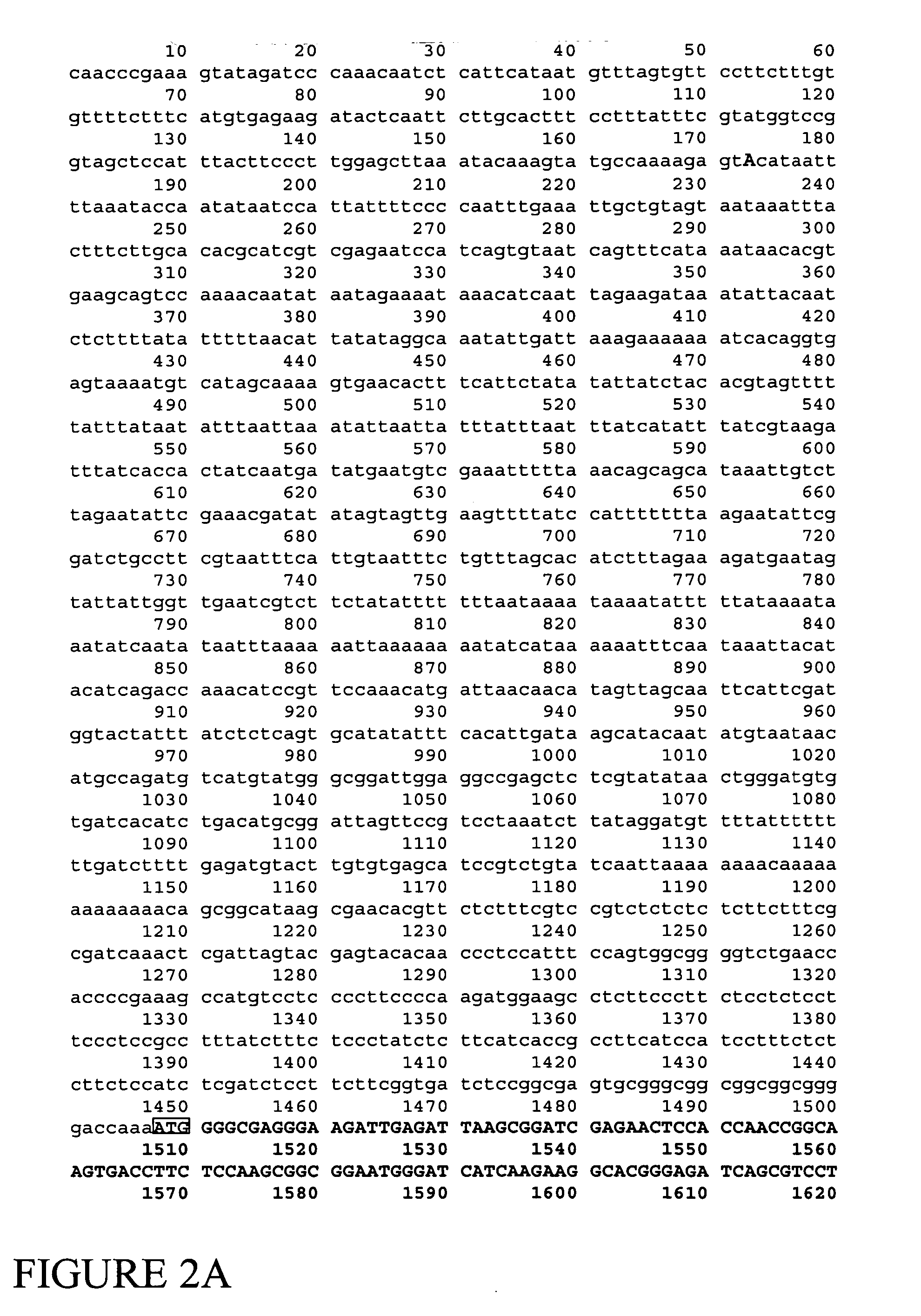Novel B-type gene from oil palm
a technology of b-type genes and oil palms, applied in the field of gene sequences and complementary forms, can solve problems affecting oil production
- Summary
- Abstract
- Description
- Claims
- Application Information
AI Technical Summary
Benefits of technology
Problems solved by technology
Method used
Image
Examples
example 1
Cloning of the MADS1 Gene from E. guineensis
(a) PCR with Degenerate Primers
[0099] One strategy to obtain a B-type gene from oil palm is the use of a degenerate primer that recognizes a conserved region specific for B-type genes. Limited homology among B-type genes outside the MADS box region has been suggested by Purugganan et al. Genetics 140: 345-356, 1995. Based on this, B-type genes from the EMBL / Genbank databases were aligned, and regions of sufficient homology were sought. One region was found in the K-box domain of the genes. Based on this homology, a new primer was designed KBOX-DOWN [SEQ. IN NO: 10].
[0100] A PCR reaction using the KBOX-DOWN primer in combination with either primer MADS5′ [SEQ. IN NO:8] or MADS5′B [SEQ. IN NO:9], i.e. primer MADS5′ optimized for B-type MADS box genes) yielded a few bands on an agarose gel. The bands were cut from the gel, re-amplified and checked for presence of the MADS box region using the MADS5′ and MADS3′ [SEQ. IN NO:7] primers, posi...
example 2
C. EXAMPLE 2
Expression Analysis of EgMADS Genes
[0117] Expression analysis of EgMADS genes was assayed in two ways: by Northern blotting and by gene-specific RT-PCR.
(a) Northern Blotting
[0118] Oil Palm inflorescence RNA from different stages of development was electrophoresed on MOPS-formaldehyde agarose gels, according to standard procedures. Three identical blots were made. The RNA was transferred to Hybond N filters by capillary blotting in 20×SSC, and hybridized to 32P-radioactively labeled cDNA fragments of the EgMADS genes. The probes (containing the 3′-parts of the EgMADS genes) were isolated by PCR and excision from agarose gels. Blots were hybridized in standard dextrane sulphate-containing hybridization solution at 65° C., and washed to a stringency of 0.1% v / v SSC, 0.5% w / v SDS at 65° C. Blots were exposed to phosphoimager plates and X-ray films.
[0119] None of the blots showed a specific signal with any of the cDNA probes. Several new attempts also failed to produce a...
example 3
D. EXAMPLE 3
Sequence Analysis of EgMADS1 in Genetically Mantled Oil Palm
[0123] EgMADS1 is a B-type MADS box gene, and is likely to be involved in specifying petals and stamens. Although no expression differences were found when comparing tissue from normal and mantled plants, it is still possible that EgMADS1 is affected somehow in the mantled plants.
[0124] Mutant oil palm plants that display the mantled phenotype are available. Therefore, the EgMADS1 sequences in both normal and genetically mantled oil palm have been examined, to see whether this gene is impaired / disrupted in the mutant, which would be a strong indication of involvement of EgMADS1 in establishing the mantled phenotype.
[0125] For this, the already-available PCR primers were used to amplify parts of the EgMADS1 gene in genomic DNA from both normal (2 samples, Eg1A and Eg2A) and mutant oil palms (4 samples). Three primer combinations were used for amplifying EgMADS1 fragments: MADS18 and MADS19 amplified a 1,200 bp...
PUM
| Property | Measurement | Unit |
|---|---|---|
| Tm | aaaaa | aaaaa |
| Tm | aaaaa | aaaaa |
| Tm | aaaaa | aaaaa |
Abstract
Description
Claims
Application Information
 Login to View More
Login to View More - R&D
- Intellectual Property
- Life Sciences
- Materials
- Tech Scout
- Unparalleled Data Quality
- Higher Quality Content
- 60% Fewer Hallucinations
Browse by: Latest US Patents, China's latest patents, Technical Efficacy Thesaurus, Application Domain, Technology Topic, Popular Technical Reports.
© 2025 PatSnap. All rights reserved.Legal|Privacy policy|Modern Slavery Act Transparency Statement|Sitemap|About US| Contact US: help@patsnap.com



